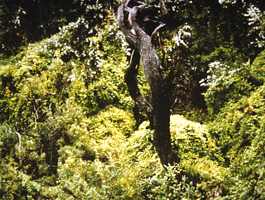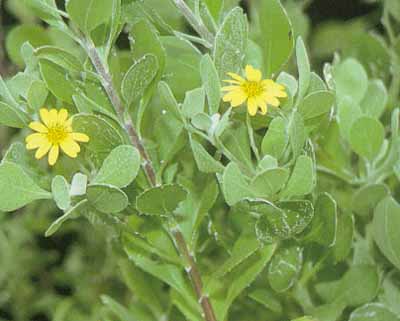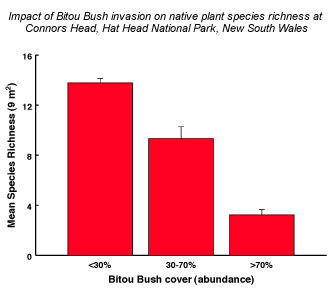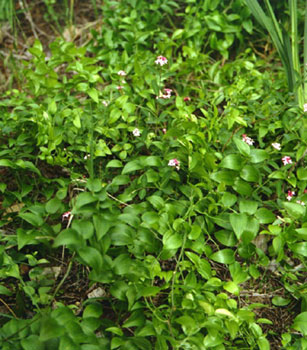Invasive Weeds

Weed invasions of natural ecosystems are among the greatest environmental threats now facing temperate Australia [CRC for Weed Management Systems]. Years of plant introductions and human settlement have led to continuing biological invasion. Some weeds are already widespread, while others are actively colonising new areas. Weeds degrade natural environments, from urban bushland to National Parks and wilderness areas, by competing with and displacing native vegetation and indirectly affecting the fauna of invaded ecosystems by altering habitat opportunities. Effective control techniques are an essential component of long-term conservation of southern Australia's ecosystems and the biodiversity represented in them. To achieve this end, it is critical that the biology, ecology and impact of these weeds be assessed and understood. An understanding of the predisposition of a system to invasion and the effects of human influence on this process is also fundamental to effective management of weed invasions.
To study the effects of environmental weeds on native plant diversity, we have chosen ecosystems in which weed invasion directly endangers some native plant species. Further, these native plant species exist mainly in two highly fragmented ecosystems - namely, the Cumberland Plain woodland in southwestern Sydney and some coastal headlands in northern New South Wales.
Weed Impacts on Biodiversity

One particularly aggressive environmental weed is Bitou Bush (Chrysanthemoides monilifera subsp. rotundata). This weed was accidentally introduced from South Africa through the dumping of ballast during the early 1900s. Subsequently, it attracted attention as a potential dune-stabilising plant and, from the mid 1940s to the late 1960s was widely planted along the New South Wales coastline to repair damage from sandmining. Deliberate plantings ceased once it became obvious that Bitou Bush was aggressively invading coastal habitats. Bitou Bush is now recognised as a Weed of National Significance in Australia and its invasion is listed as a key threatening process under schedule three of the New South Wales Threatened Species Conservation Act 1995. It forms a dominant part of the flora along 80% of the New South Wales coastline where it invades a range of native plant communities including beach-dune vegetation and adjoining coastal grasslands, heathlands, woodlands, forests and rainforests.
Despite recognition of the species' invasive status at the National and State level, little quantitative information is available on the effects of Bitou Bush invasion on native plant diversity. Current research aims to quantify impact on grassy-dwarf heathland vegetation on headlands in northern New South Wales. This vegetation type supports populations of at least two nationally threatened plant species, Zieria prostrata and Thesium australe, whose continued survival is directly threatened by Bitou Bush invasion. Vegetation and soil-stored seed bank sampling has been conducted on four headlands invaded by Bitou Bush to determine the above and below ground impacts of invasion on native plant diversity. Preliminary analysis indicates that Bitou Bush invasion impacts are severe - declines in the richness and local abundance of native plant species are principal effects.

The results of this study will contribute towards an increased understanding of the impacts imposed by Bitou Bush specifically, and environmental weed species generally, on native plant diversity. Understanding the invasion ecology, patterns and impacts of invasive weeds assists in determining the threat posed to biodiversity values and guides managers with the prioritisation and targeting of limited resources.
Aspects of an integrated Bitou Bush control trial involving herbicide and burning treatments were implemented at Bare Bluff in northern New South Wales in collaboration with New South Wales National Parks and Wildlife Service and local conservation groups. Results from this study will contribute to more effective integrated management of Bitou Bush. Expected outcomes of a 'best practice' integrated control program for this species will include - (i) reduced density and reproductive vigour of Bitou Bush, (ii) increased plant community resilience to invasion and low risk of re-invasion by Bitou Bush or other weeds, (iii) enhancement of biodiversity values, and (iv) reduced risk of local extinction of native plant species that are directly threatened by Bitou Bush.
Scientific Staff: Groves, Mullett
TOP
Remnant Vegetation in the Cumberlands Plains
Cumberland Plain vegetation is typically eucalypt woodland with a ground cover of native perennial grasses such as Kangaroo grass. Shrubs are common but sparse and include Bursaria, Pimelea spicata and various Acacia spp. (some of which themselves are rare). This vegetation type occurs on clay loams of moderate fertility overlying extensive Cumberland Plain shales. It was this open vegetation on soil of moderate fertility that comprised the prime areas for early agricultural development for the fledgling settlement of Sydney. Now, 200 years later, they are overwhelmingly covered by suburbia, few reserves of natural vegetation exist and those that do are highly fragmented. Cumberland Plain woodland is the first natural vegetation type to be declared 'endangered' federally.

Bridal Creeper (Asparagus asparagoides) is a primary threat to Pimelea spicata, a rare shrub threatened with extinction unless adequate management strategies are initiated. Bridal Creeper was deliberately introduced into Australia from South Africa for horticultural purposes, but has successfully invaded a range of communities in most Australian states. It is regarded as one of the most serious environmental weeds of southern Australia and is, therefore, the subject of an active biological control program through the CRC for Weed Management Systems. This project aims to quantify the impact of bridal creeper on biodiversity loss by focusing on its interaction with P. spicata. An advantage of the 'single species' vs 'community' approach is that the processes and mechanisms of weed invasion can be determined relatively easily, in addition to examining the post-invasion patterns of species-change, as previous studies have emphasised. Field surveys and manipulated experiments will determine the weed's impact on key phases in the life history of P. spicata under a range of environmental circumstances.
Many of the introduced weeds, including bridal creeper, which endanger native plant diversity in the Cumberland Plain woodland are bird-dispersed. An ongoing project builds on work targeting species-specific interactions between bridal creeper and native plants in one fragment (see above). The introduced flora of a range of fragments of the Cumberland Plain woodland has been documented,with the majority of these species being bird-dispersed. Conclusions from the work on bridal creeper can be widened thereby to cover environmental weeds generally in relation to diversity of the most endangered of natural ecosystems in southeastern Australia. We are currently testing specific hypotheses concerning the role of edge length, distribution of perching trees and the dispersal by birds of common environmental weeds such as broad-leaved privet and African olive in relation to fragment size and shape.
Scientific Staff: Groves
